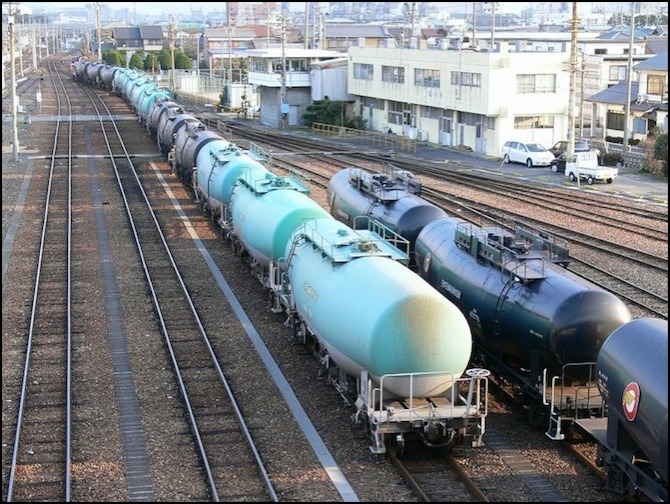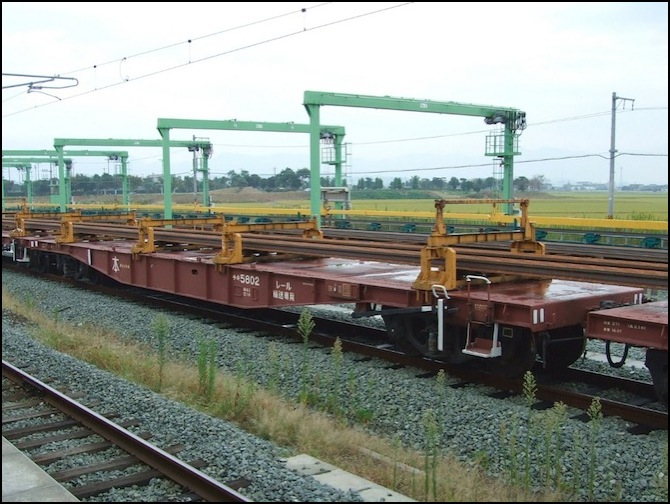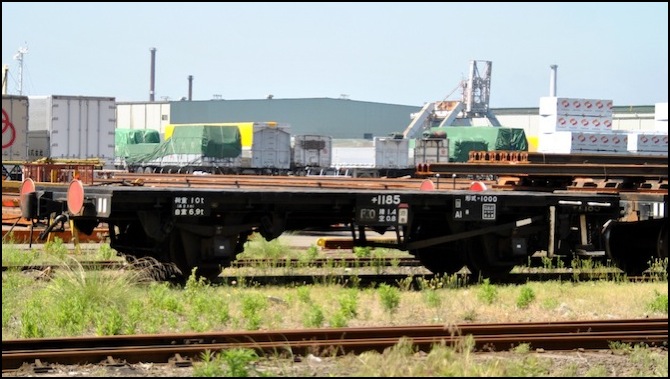Unit Freight Trains
Most freight in Japan today that still moves by rail, travels in unit trains. While unit trains are popular worldwide for their economics, most other railways still provide for carload freight, where a single car, or a couple of cars, travel in a mixed train with others, and are sorted at intermediate yards before being placed into a private siding at an industry, or left on a “team track” at a station for unloading. But Japan closed all of its general freight classification yards in 1985 as part of JNR’s cost-cutting drive to stem massive losses (due to poor management more than anything, although Japan suffered the same loss of high-profit express freight to trucks as other railroads).
The caboose also went out of general use in 1985, but will still sometimes be used on the ends of special-purpose trains. I’ve seen video showing them on Welded Rail trains and for transporting new passenger cars, but not on the end of any modern unit container, tank or hopper train.
This page identifies several common types of unit freights still found in Japan today, along with some detail on typical sizes and compositions (culled from watching YouTube videos, among other sources).
Container Freight
Container-on-flatcar is very big in Japan. JR Freight operates a network of container yards, where domestic containers can move between rail and freight. There are also a few dedicated unit trains that shuttle between two fixed endpoints, either for one customer or to connect shared yards such as interchanges, carrying specialized cargos in container form, such as auto parts or containers of express freight. These are described in more detail on my Express Freight page.
Petroleum Tank Trains
A variety of petroleum products move in unit tank trains. One of the big ones seen around Tokyo are jet fuel moving from the port to a U.S. airbase, but there are many others.
TAKI 1000-series oil tank trains are classed as a “B” high speed freight, meaning having a top speed of 95 kph.

TAKI 1000 tank cars at Shiohama Station (2006)
Photographer: Chabata_k
Crushed Stone
There is a lot of construction in Japan, and crushed stone needs to be moved to building sites or cement factories serving them. Often this will be done using hopper cars.
Coal
Japan’s domestic coal is of sufficiently poor quality that little is mined anymore, and even less moves by rail. Although depending on the state of the world market, “less” doesn’t always mean none. This was typically short-hauled from mine to port, since transporting coal over long distances within the country is generally cheaper by ship, and export needs to be via ship anyway. One interesting exception to this is a unit coal train operating from Tokyo’s waterfront to an inland cement producer with a coal-fired power plant. The actual coal is imported.
A typical length for this train seems to be ten cars, although it may leave the port as two ten-car sections that will be separated later and delivered to different plants. The length is probably related to the capacity of the sidings at the power plants, but I don’t know that for certain.
Welded Rail
This is an interesting form of maintenance-of-way train. Rail is typically manufactured in relatively short lengths that can be transported by truck or ship, or within the length of a single railway car. Over the years these have become longer, with 25m (82’) typical today in Japan. These may be used singly, or more commonly welded into continuous lengths in the field. However it has become common practice to pre-weld them into longer sections (a quarter-mile, or 402 m, is typical in the U.S.) and transport them on strings of specialized flat cars. In Japan, the same is done. However as one common practice is to install rail in 200 m lengths to provide for expansion joints, rather than continuous welding, this length is more likely to be used for pre-welded sections.
The TIKI (or CHIKI, チキ) 5500 flat car is often used as the basis for a custom rail transport car, but other models have been used and it is also possible to use a standard flat car with an attached support structure.

TIKI 5500 (5802) at Onga Station (2007)
Photographer: Muyo Master
The two-axle TI (or CHI, チ) 1000 flat car is also common in these trains, used at the ends or as a spacer between longer cars.

TI 1000 at Sendai (2010)
Photographer: Kuha455405
According to the Japanese Wikipedia page for the 5500 (see link below), rail may be transported in three-car trains (for 50m lengths), used by JR Freight to move tail from steel mill to destination, or ten-car trains (for 200m lengths), used by other JR Group companies to move 200m rail segments. I’m not sure I completely buy that, as I’ve seen video of trains in the seven to eight-car length, and those seemed to be transporting long sections of rail, but perhaps those were two three-car loads with a spacer between them.
JR East operates a rail-welding facility and trans-shipping dock at Shiohama, Tōkyō, on the Etchūjima Freight-traffic Line (越中島貨物線), see my page on Non-Freight Lines for more on that.
Welded rail trains are often pulled by a single DE10 locomotive, even in electrified territory. Sometimes the train will contain an old low-sided hopper car, likely being used to carry ties or other material used in track maintenance. I’ve seen video with a YO 8000 caboose on the end, but this seems very uncommon.
References
Japanese Wikipedia page for 5500-series flat cars.
Japanese Wikipedia page for Chobutsu Cars (長物車), specialized-cargo flatcars.
Photo page showing structures on a typical North American welded-rail train.
The Mechanism of Railway Tracks, Shigeru Miura, Hideyuki Takai, Masao Uchida and Yasuto Fukada, JRTR Issue 15, March 1998.
A good general overview of Japanese rail track structure, with a focus on Shinkansen design.




